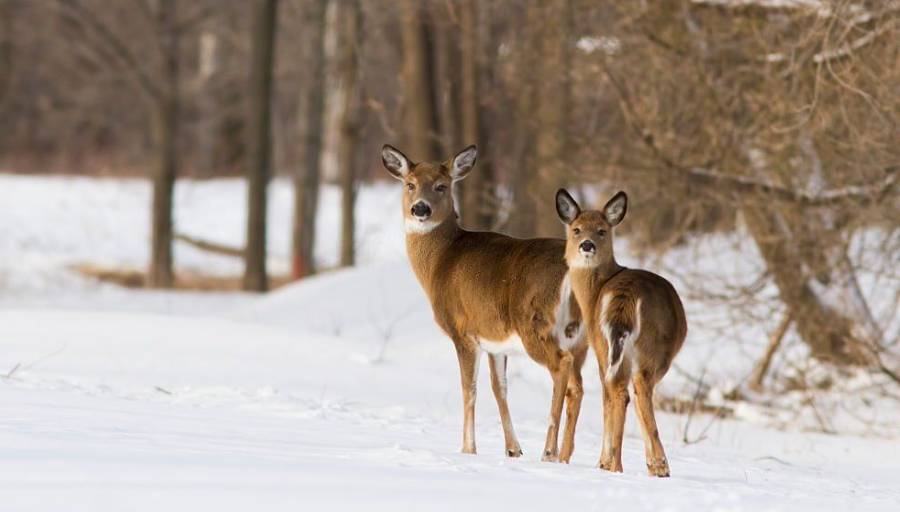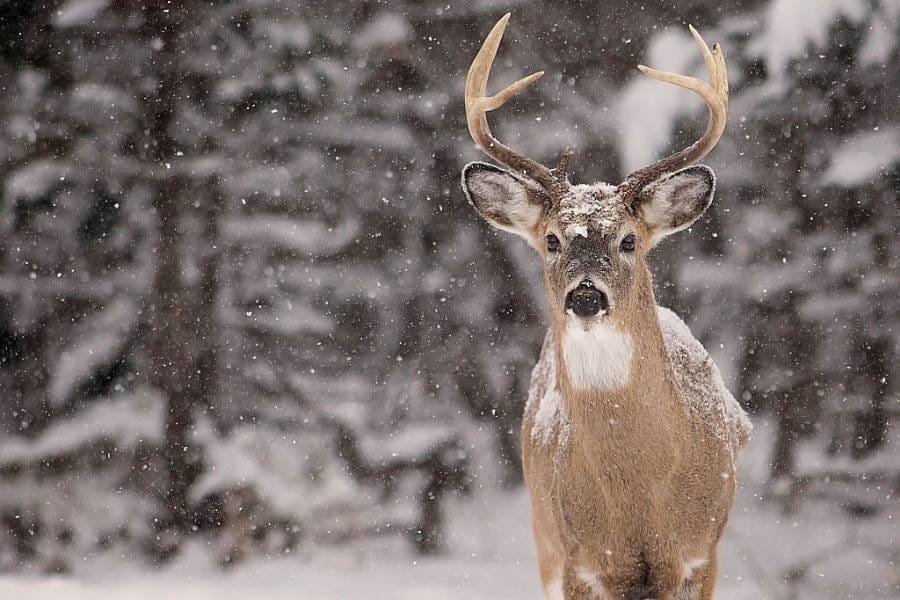
Deer are known for their ability to survive and thrive in a variety of environments, including snowy weather. However, their movement patterns can be affected by the presence of snow on the ground. Deer will generally move more during the day in snowy weather because they need to eat more frequently to stay warm. They will also tend to stick to well-established trails and paths, as moving through deep snow can be energy-intensive.
Additionally, deer seek out areas with less snow cover, such as south-facing slopes where the snow has melted, or areas with more cover, such as dense coniferous forests, where they can stay protected from the elements. Understanding how snowy weather affects deer movement patterns can be useful for hunters and wildlife enthusiasts alike.
Will Deer Move When It’s Snowing?
Yes, deer will move when it’s snowing, but the extent to which they move depends on the severity of the snowfall. In light snowfall, deer move more frequently during the day to search for food and avoid predators.
However, in heavy snowfall, deer may hunker down and conserve their energy by staying in sheltered areas or bedding down in thick cover. During a snowstorm, deer are also less likely to move far from their bedding areas, as the falling snow can make it more difficult for them to see and navigate their surroundings.
It’s worth noting that different factors can affect deer behavior during snowy weather, such as temperature, wind, and available food sources. So while deer be more active during a snowfall, it’s not a guarantee, and it’s important to consider these other factors when trying to predict deer movement patterns.
Do Deer Move Before or After Snow?
Deer movement patterns can be influenced by changes in weather conditions, including snowfall. Deer tend to be more active before a snowstorm, as they may sense the change in barometric pressure and instinctively know that they will need to feed more before the snow arrives. They also move more during this time to secure food sources and prepare for the potentially harsh conditions ahead.
After a snowfall, deer are more cautious and move less, especially if the snow is deep or the temperature is very cold. They stick to established trails and areas with less snow cover to conserve energy and reduce their risk of getting stuck in deep snow. However, deer will still need to feed, so they move more during the day to search for food sources.
However, the exact timing and extent of deer movement before and after a snowfall can vary depending on factors such as the severity of the snowstorm, the temperature, and the availability of food sources.
How to Hunt Deer in 8 Kinds of Snow?

Hunting deer in different types of snow requires different strategies and techniques. Here’s an in-depth guide on how to hunt deer in eight common types of snow:
Fresh Snow
Freshly fallen snow can be a great time to hunt deer as it can reveal their tracks and make it easier to track them. Look for areas where deer have crossed roads or trails, and follow their tracks to find feeding or bedding areas. Fresh snow can also make it easier to spot deer, as their dark bodies stand out against the white background.
Packed Snow
Packed snow can be more challenging for hunting, as it makes it harder to see deer tracks and requires more effort to move through. Look for areas where deer have broken through the snow to find feeding areas, and follow established deer trails or game trails through the woods.
Crusty Snow
Crusty snow can make it difficult for deer to move, so they may stick to areas with less snow or travel on well-established trails. Use snowshoes or cross-country skis to move through the crusty snow and follow deer tracks to find feeding or bedding areas.
Deep Snow
Deep snow can make it challenging for both hunters and deer. Deer stick to areas with less snow or travel on well-established trails. Look for areas with less snow, such as south-facing slopes or areas with dense cover, and follow deer tracks to find feeding or bedding areas.
Wet Snow
Wet snow can be noisy to walk through, so move slowly and carefully to avoid spooking deer. Look for areas where deer have been feeding or bedded down, and use a tree stand or ground blind to stay hidden while waiting for deer to pass by.
Light Snow
Light snow can make it easier to see deer tracks and can make it easier to move quietly through the woods. Look for areas where deer have been feeding or bedded down, and use a tree stand or ground blind to stay hidden while waiting for deer to pass by.
Heavy Snow
Heavy snow can make it difficult for deer to move, so they stick to areas with less snow or travel on well-established trails. Look for areas with less snow, such as south-facing slopes or areas with dense cover, and follow deer tracks to find feeding or bedding areas.
Frozen Snow
Frozen snow can be noisy to walk on, so move slowly and carefully to avoid spooking deer. Look for areas where deer have been feeding or bedded down, and use a tree stand or ground blind to stay hidden while waiting for deer to pass by.
Regardless of the type of snow, it’s important to be patient and observant when hunting deer. Look for signs of deer activity, such as tracks, droppings, and feeding areas, and stay alert for any movement or sounds that may indicate the presence of deer. Finally, always follow safe hunting practices and respect local hunting laws and regulations.
Conclusion
Deer do move in the snow, although the extent and timing of their movement can vary depending on the severity of the snowfall and other factors such as temperature and food availability. Understanding these patterns is key to successfully hunting deer in the snow.
When hunting deer in the snow, make sure to adapt your approach to the specific type of snow present. Fresh snow can make it easier to track and spot deer, while deep or packed snow requires more effort to navigate. Wet or frozen snow can be noisy to walk on, so hunters should move slowly and carefully. Regardless of the type of snow, patience, and observation are key to success.
Frequently Asked Questions and Answers
Here are some frequently asked questions and answers about deer and their behavior in snowy conditions:
Do deer migrate during the winter?
Yes, some deer species do migrate during the winter in search of food and shelter. However, not all deer populations migrate, and some stay in their home range throughout the winter.
Do deer hibernate in the winter?
No, deer do not hibernate. They remain active throughout the winter and must find food and shelter to survive.
Do deer move more in the snow?
Yes, deer are known to move more in the snow because they need to find food and avoid predators. Snow can also make it more difficult for deer to find food, so they need to travel further to locate it.
Do deer use the same trails in the snow?
Yes, deer often use the same trails in the snow because they provide a clear path and are easier to navigate. These trails can be used by multiple deer and can become well-worn over time.
Do deer bed down in the snow?
Yes, deer will lie down in the snow to rest and conserve energy. They use their body heat to create a depression in the snow and then lay down in it to stay warm.
Do deer eat snow?
No, deer do not typically eat snow. They eat snow if they are thirsty and cannot find a water source, but they prefer to drink liquid water when available.
Do deer have adaptations for snowy conditions?
Yes, deer have several adaptations that help them survive in snowy conditions. These include a thick winter coat, large ears that help regulate body temperature, and the ability to grow extra muscle mass to stay warm. They also have large hooves that help them navigate through snow and can close their nostrils to prevent snow from entering their nose when they are foraging.
What is dry snow, and how does it affect deer hunting?
Dry snow is light and fluffy and can make it easier to see deer tracks. However, it can also be noisy to walk through and may spook deer.
What is wet snow, and how does it affect deer hunting?
Wet snow is heavy and can make it more difficult to move through the woods quietly. It can also cover up tracks and make it harder to see deer.
What is crusty snow, and how does it affect deer hunting?
Crusty snow has a hard top layer that can make it easier to walk on. However, it can also be noisy and make it harder to hear approaching deer.
What is slushy snow, and how does it affect deer hunting?
Slushy snow is wet and heavy and can make it difficult to move through the woods. It can also cover up tracks and make it harder to see deer.
What is icy snow, and how does it affect deer hunting?
Icy snow can make it difficult to walk through the woods safely, and it can be noisy to move through. However, it can also be easier to see deer tracks in icy conditions.
What is powdery snow, and how does it affect deer hunting?
Powdery snow can make it easier to see deer tracks, but it can also be noisy to move through. It can also be difficult to navigate through deep powder.
See Also…